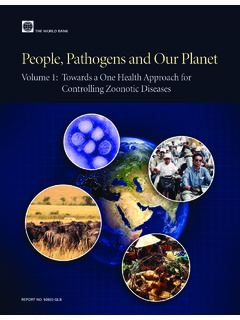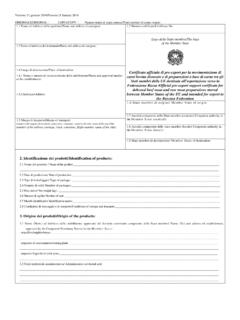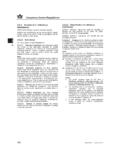Transcription of Contagious bovine pleuropneumonia - Home: OIE
1 Contagious bovine pleuropneumonia What is Contagious General Disease Information Sheets bovine pleuropneumonia Contagious bovine pleuropneumonia (CBPP) is a disease of cattle and water buffalo caused by Mycoplasma mycoides subsp. Mycoides (M. mycoides). As the name suggests, it attacks the lungs and the membranes that line the thoracic cavity (the pleura) causing fever and respiratory signs such as laboured or rapid respiration, cough and nasal discharges. Because it is highly Contagious with a mortality rate of up to 50%, it causes signi cant economic losses. CBPP is a prominent cattle disease in Africa. CBPP is a disease listed by the OIE in the Terrestrial Animal Health Code. Member countries are obligated to report occurrences of the disease according to the standards in the OIE. Terrestrial Animal Health Code. CBPP is one of the diseases for which the OIE has of cial recognition status. The OIE. Terrestrial Animal Health Code speci es the steps a country must follow in order to be of cially recognized by the OIE as free of CBPP.
2 1. Where is the disease found? How is the disease General Disease Information Sheets CBPP was known in Europe as early as the 16th transmitted and spread? century. It was spread throughout the world by Transmission of the disease occurs through direct increased international trade in live cattle in contact between an infected and a susceptible the second half of the 19th century. Stamping animal which becomes infected by inhaling out policy eradicated the disease from many droplets disseminated by coughing. Since some countries; however it currently persists in sub- animals can carry the disease without showing Saharan Africa. signs of illness, controlling the spread is more dif cult. There is no evidence of transmission through fomites (inanimate objects such as clothing, implements or vehicles) as the organism does not persist in the environment. 2. What are the clinical signs How is the disease of the disease? diagnosed? CBPP is manifested by loss of appetite, fever and The diagnosis is based on isolation of M.
3 Mycoides respiratory signs, such as rapid respiratory rate, from samples such as nasal swabs and/or lung cough and nasal discharges and painful, dif cult washings or pleural uid obtained by puncture, or breathing. In hot climates, an affected animal often necropsy samples. The Manual of Diagnostic Tests stands by itself in the shade, its head lowered and and Vaccines for Terrestrial Animals details the extended, its back slightly arched, and its limbs diagnostic procedures for CBPP. turned out. In many cases, the disease progresses rapidly, animals lose condition, and breathing becomes very laboured, with a grunt at expiration. The animals become recumbent (lie down) and in severe cases die after 1-3 wk. The mortality rate may be as high as 50% in the absence of antibiotic treatment. However, clinical signs are not always evident. Subacute or asymptomatic forms can occur as affected animals partially recover after a period of three to four weeks. However, these cattle may be capable of spreading the disease, acting as unapparent carriers.
4 Contagious bovine pleuropneumonia 3. Contagious bovine pleuropneumonia What is being done to prevent Vaccination with an attenuated strain of the bacteria is used to reduce the level of infection. Vaccine is or control the disease? produced following the guideline in the OIE Manual The main problems for control or eradication are of Diagnostic Tests and Vaccines for Terrestrial the frequent occurrence of subacute or unapparent Animals. infections and the persistence of chronic carriers after the clinical phase. In most continents, control strategies are based What is the public on the early detection of outbreaks, control of animal movements and a stamping-out policy. health risk associated This has successfully eliminated the disease from with this disease? North America and Europe. In Africa control of the disease is currently based mainly on vaccination Humans are not known to be susceptible to campaigns. Contagious bovine pleuropneumonia , so there is no public health risk.
5 Surveillance of the disease through slaughterhouse inspection is a very ef cient method of detecting clinical cases. Treatment of affected animals with antibiotics can result in healthy looking animals that are still infected and able to spread the disease, so it is not recommended. 4. More Information? References: Ask our experts: General Disease Information Sheets 1. OIE Terrestrial Animal Health List of Reference Laboratories: Code: c- expertise/reference-laboratories/. standard-setting/terrestrial-code/ list-of-laboratories/. access-online/. 2. OIE Manual of Diagnostic Tests List of Collaborating Centres: and Vaccines for Terrestrial c- Animal: expertise/collaborating-centres/. list-of-centres/. standard-setting/. terrestrial-manual/access-online/. 3. OIE Technical Disease Card: health-in-the-world/. technical-disease-cards/. 4. The Center for Food Security and Public Health, Iowa State University 5. Merck Veterinary Manual: le=htm/bc/. 6. Atlas of Transboundary Animal Diseases Animales Transfronterizas P.
6 Fernandez, W. White;. Ed.: 2011. 5. Key Facts One of the three great historic cattle After its elimination from Europe in the plagues of the world, (along with Foot and nineteenth century, the disease reappeared Mouth Disease and Rinderpest), CBPP was in Portugal and Spain in 1951 and first recognized in Germany in 1693. The 1957, respectively. A few outbreaks were history of its introduction to countries and reported in southern France, the latest in subsequent eradication often parallels the 1984. In Italy, the disease reappeared development of veterinary services. in 1990 but was eliminated by 1993, and the last case in Europe was in Portugal The USA has been free of the disease since in 1999. 1892, the UK since 1898, Zimbabwe since 1904, South Africa (where the disease was introduced by the importation of infected bulls from Holland in 1853) since 1924, Australia since 1970s and China since the 1980s. 12, rue de prony 75017 paris france tel. 33 (0)1 44 15 18 88 - fax 33 (0)1 42 67 09 87.
7 Cover photo: OIE. Inside photos: OIE, INRA, INRA, INRA. 6.














